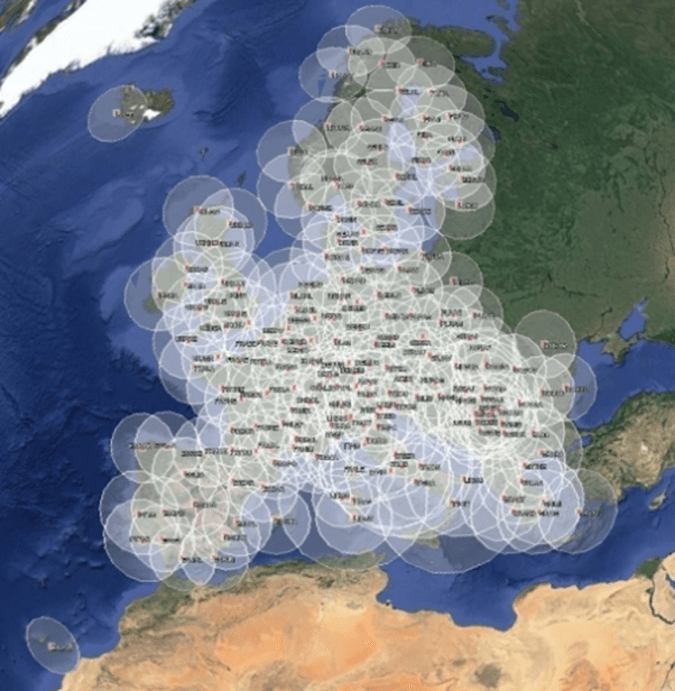Meteorological agencies around the world use radar to detect weather phenomena. Wind turbines are large structures that due to their size and operation can interfere with the detection capabilities of weather radar (i.e. weather forecasting, precipitation measurements, extreme weather phenomena warnings, etc.).OPERA, an EUMETNET working group has previously investigated the interference mechanisms and produced guidelines for safeguarding weather radar from wind turbines. A quick review of these guidelines is presented in this article.
Radar
The purpose of RADAR (Radio Detecting and Ranging) is to detect objects at far distances. This is undertaken by sending frequent radio signals and then ‘listening’ to the responses. Detected targets can include flying objects and weather phenomena such as rain, snow and hail. Radar used specifically for weather phenomena are usually termed weather or meteorological (met) radar.
What is OPERA?
OPERA is an EUMETNET working group in 31 member states which facilitates the European meteorological radar network. Member states include:
| • Austria | • Belgium | • Bulgaria |
| • Cyprus | • Croatia | • Czech Republic |
| • Denmark | • Estonia | • Finland |
| • Germany | • Greece | • Hungary |
| • Iceland | • Ireland | • Italy |
| • Latvia | • Luxembourg | • Malta |
| • Netherlands | • Norway | • Poland |
| • Portugal | • Romania | • Serbia |
| • Slovak Republic | • Slovenia | • Spain |
| • Switzerland | • United Kingdom |
As of September 2013 the OPERA network had 202 operational weather radar among country members. The radar coverage of the European network can be seen in figure 1.
 Figure 1: European weather radar network coverage
Figure 1: European weather radar network coverage
Wind turbine interference
Weather Radar may detect non weather / meteorological echoes. These can be caused by terrain (hills), man-made objects (buildings), aeroplanes, sea waves and wind turbines.
Over the last 10 years the proliferation of wind turbines in the vicinity of weather radar coupled with the observed effects from operational wind turbines lead to the investigation of the interference mechanisms. OPERA research [1],[2],[3] concluded that there are three interference mechanisms:
- Blocking of the radar beam due to the physical obstruction of the radar beam which can lead to … an underestimation of the precipitation measurements and a loss of sensitivity of Doppler measurements.
- Clutter due to the reflection of the signals emitted by the radar which produces signals several orders of magnitude higher than those produced by typical weather phenomena such as rain.
- Doppler mode due to the shift in the phase of a signal as a result of the rotating blades.
Doppler mode interference was deemed by OPERA to be the most significant.
Based on the produced guidelines [1],[2],[3] and specific collaboration between Denmark (DMI), Germany (DWD), Spain (INM), Netherlands (KNMI), Météo-France and UK Metoffice OPERA recommended that no turbines should be built at distances of:
- <5km from a C band weather radar
- <10km from an S band weather radar
Furthermore, an impact assessment should be undertaken when the wind turbine(s) are planned within:
- 5 – 20km of a C band weather radar
- 10 – 30km of an S band weather radar
Conclusions
OPERA guidelines provide a starting point for screening potential weather radar interference issues and objections from relevant authorities. However, being in the vicinity of a weather radar is not necessarily a showstopper and there are ways that the potential impacts could be examined and mitigated.
References:
[1] Opera II WP 1.8, WD_2006_18 Impact of Wind Turbines on Weather Radars, OPERA Group EUMETNET (December 2006).
[2] Opera III WP 1.5b OPERA_2010_05 Site protection (wind turbines),OPERA Group, EUMETNET (October 2010).
[3] Statement of the OPERA group on the cohabitation between radars and wind turbines, OPERA Group, EUMETNET (2010).
Image accreditation: Google earth, Data SIO, NOAA, U.S. Navy, NGA, GEBCO, Image Landsat, Image IBCAO, Image U.S. Geological Survey. Imagery Date: 4/10/2013
